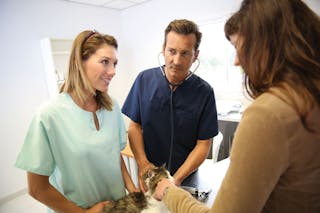
Being a good vet (Part 1)
“If your only tool is a hammer, all problems resemble a nail”. This section will stress the different factors required to make you a “good clinician”
DVM
Blättner 박사는 베를린과 뮌헨에서 공부했으며 1988 년 졸업 한 후 자신의 작은 동물 연습을 시작하고 운영했습니다. 그런 다음 그녀는 오스트리아 린츠 대학교에서 교육 및 코칭에 대한 대학원 과정을 마친 후 수의사 및 수의 기술자에게 강의, 세미나 및 사내 교육. 그녀는 두 개의 수의학 저널을 편집 할뿐만 아니라 20 개 이상의 국가에서 수의사를 훈련하는 Royal Canin과 함께 작업합니다.
아래의 저자가 작성한 기사 및 발행호를 검색해보세요.

“If your only tool is a hammer, all problems resemble a nail”. This section will stress the different factors required to make you a “good clinician”

Finally, some tips to improve your follow-up strategy.

This chapter will give you practical tips (what to do, what not to do, main pitfalls, etc.) on blogs, websites and social media and how to encourage clients to leave positive reviews on the web.

Based on studies on a human hospital, this chapter will outline the different steps in the pet owner journey in your practice, including the consultation that should be a “golden moment” for your client.

บทความนี้จะนำเสนอแนวทางการเข้ารับบริการในสถานพยาบาลสัตว์ของเจ้าของสัตว์เลี้ยงรวมไปถึงการตรวจรักษาซึ่งถือเป็นช่วงเวลาที่มีค่าสำหรับเจ้าของผ่านการศึกษารูปแบบการทำงานของโรงพยาบาลคน สัตวแพทย์และบุคลากรในสถานพยาบาล...

Internet has changed the “pet owner journey”: before telephoning a vet to ask questions or actually taking an appointment, the client will search the Internet (sometimes just to find a telephone number) and will have first information about your practice through it.

Vet practitioners are often not aware of their environment. They never stay in the waiting room of their practice for long. They sometimes even enter the practice through a different door than the one used by their clients.

Most veterinarians are not comfortable when discussing fees, or when asked to "sell" something, but this is normal! This chapter offers a method which will allow you to prescribe or recommend products and services effectively.

It’s never too early to think about the future. For many young veterinary surgeons, their job is primarily the result of a passion for pets.

Understanding the various factors involved that contribute to the income and expenditure of a veterinary clinic is key for long-term success.

This part will cover the art of communication, especially when dealing with pet owners, because nothing is more frustrating than a lack of compliance when treating an animal.

Once you've accepted a post at a practice, you'll need to learn how to manage people. You'll also need to take care of yourself to avoid burn-out. This chapter tells you how.
